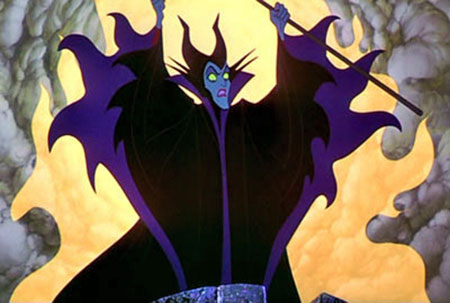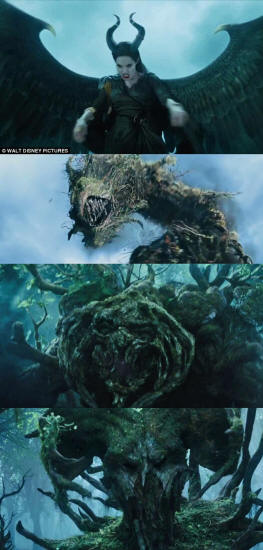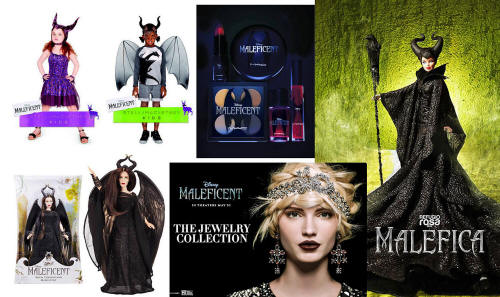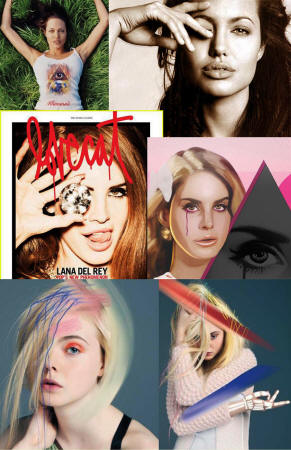|
Angelina Jolie as Maleficent
Disney is seen around the world as a source of wholesome entertainment for children, but is there a darker side to its productions hidden in plain sight? This article investigates occult references in Disney productions, how society's values and perception of good and evil are under threat, and the effect this could have on the future of spirituality.
Question for you:
If the first thing that comes to mind is a demon you're not alone - they've been represented like that for centuries.
But if you are one of the 35 million or so people who have recently seen Disney's latest movie Maleficent, you might be feeling a bit confused, or your answer might even be quite different.
Maleficent's Disney Origins
In the credits of Maleficent is the following text:
To make sense of the film then let's take a quick look at the origins of Disney's most infamous villain in the 1959 animated movie Sleeping Beauty.
Sleeping Beauty follows the story of Princess Aurora. At a celebration of her birth she is cursed by the "wicked witch" Maleficent to die on her 16th birthday (a number which in numerology relates to spiritual fragility and falling towards darkness) by pricking her finger on the spindle of a spinning wheel.
The curse is weakened by the magic of a good fairy whose intervention saves the princess from death, and instead of death the curse puts her in a deep sleep, a state she must remain in until awakened by true love's kiss.
Maleficent, self-proclaimed "mistress of all evil"
In Sleeping Beauty, Maleficent is the self-proclaimed mistress of all evil.
She has a pet raven named Diablo (the Spanish word for "Devil") and even her name itself means doing evil or harm or to be harmfully malicious, a word originally coming from the Latin Maleficus which means "wicked or prone to evil".
She is said not to know anything about love, kindness, or the joy of helping others.
Maleficent has an evil looking goblin army (whom she refers to as fools, idiots, imbeciles and a disgrace to the forces of evil) and in the final battle before Aurora's true love Prince Philip saves her from her slumber, Maleficent transforms into a giant dragon with all the powers of the abyss behind her. Sounds like a lovely person.
Maleficent is part of a sub-franchise of Disney Villains called the Diva's of Darkness and is included in a merchandising line called the "Villains Designer Collection" that "re-imagines the stylish wickedness of classic Disney Villains" in order to capture the essence of their evil.
In later crossover appearances by Maleficent she acts as the leader of the Disney Villains and was ranked number #1 in Ultimate Disney's top 30 Disney Villain's countdown (Source).
And this is where it gets confusing, because despite being based on Sleeping Beauty's evil villain, in Disney's new movie Maleficent, this character is made out to be good.
But Maleficent Wasn't Really Evil, She Was Just Misunderstood…
Maleficent and the creatures from the shadows that fight the invading humans
At the beginning of Maleficent the narrator gives a bit of back story about the child-fairy Maleficent and then triumphantly proclaims "And her name is Maleficent" (remember the meaning from before?).
As Maleficent grows she becomes strong, a protective figure for the spirit realm where she lives which is composed mostly of good and innocent elementals.
When "evil" humans come to invade her kingdom she calls on those who "live in the shadows" to "arise" and stand with her, causing a series of demon-looking figures to emerge from the ground and the forest.
Interestingly one of them looks very similar to another movie demon who lives in the shadows; the Balrog of Mordor.
This "demon of the ancient world" is defeated by the magician Gandalf who represents the white side of esotericism in the Lord of the Rings saga.
Later Maleficent rules over the spirit world in darkness with the king of the demon-looking creatures forcing the innocent spirits into submission. Interestingly, the name of this demon king is Balthazar, possibly a mockery of one of the three wise magi in the story of the birth of Christ.
The good fairies, who in Sleeping Beauty weaken Maleficient's curse and give Prince Philip the weapons and power to destroy Maleficient, are shown as ditzy and useless and we are submitted to many scenes which are surprisingly dark and violent for a film aimed at children.
But then something happens.
The plot causes us to start sympathizing and identifying with Maleficent. She is not so bad. She becomes Aurora's "fairy godmother" and in the end is the hero, a savior of the two kingdoms who defeats the evil king (who we are made to feel negative towards as he is full of obsessive hatred).
A bright light illuminates Maleficent and inspiring music plays as (looking like what most people would think of as a demon) she ascends. Darkness is upheld as virtuous and as I watched I was left feeling confused - what just happened, who was bad, who was good, did darkness win?
The film ends with Maleficent flying towards the sun, while the background music changes from inspiring to slightly creepy giving us an indication that not all may be what it seems.
Popularizing Evil?
People 'trust' Disney to provide their children with wholesome entertainment, and it seems only recently that some parents are discovering there is more to what Disney is teaching our kids than what was initially thought.
If the US ticket earnings for Sleeping Beauty are adjusted for inflation, then it earned the equivalent of $578.5 million dollars at the box office by today's standards, making it one of the top 40 highest-earning films of all time.
This is significant - it's a film most parents would have seen and would be likely to take their children too. It's unsurprising then that Maleficent has grossed almost $756.5 million worldwide - that's a whole lot of people who might now be looking at evil in a different light.
Despite what Angelina Jolie said about Disney films above, it's hard to imagine that a film as dark as this would not leave an imprint on the people who saw it, especially the impressionable minds of kids.
Personally some of my most horrific and recurring nightmares as a child came from the scarier aspects of Disney films, but in the olden days good and evil were clearly defined, whereas nowadays the lines are blurred - are we being shown that darkness is not so bad, that we should embrace and support it?
Some possible clues come in an article from Entertainment Weekly.
Angelina (who was also an executive producer for the film) talks about how when she was growing up she identified with Maleficent.
Angelina knew the film needed to be beautiful but also, "a little sexy and [a] little darker" because it was made from the point of view of the villain.
Angelina's costume was so dark in fact that her daughter had to be cast for a minor role as young Aurora because all the other child actors were afraid of her eyes, claws and horns.
Studio production chief Sean Bailey also chimed in saying that while the earlier film would be referred to in many ways,
After watching the film we are encouraged to indulge our interest in the dark side, as a whole range of merchandise has sprung up as a result of the movie.
There are Maleficent dolls similar to Barbies, Maleficent make up, Maleficent jewellery - even a line of dress up Maleficent costumes for kids.
suggesting parents help their kids channel their dark side
On the Disney Facebook page we see a suggestion for parents to "help [their] kids channel their inner Maleficent with horn craft", a sentiment that is repeated on the Perez Hilton website in promoting the Maleficent clothing line "for the little ones that would like to channel their bad side".
Do we really want our kids channeling anything, let alone things which are knowingly dark?
It's clear that the Disney Corporation understands the workings of the human psyche.
It would seem unlikely that they are unaware of the effect that statements and productions like this would have on kids.
Occult Symbolism in Maleficent
From top to bottom: Angelina Jolie, Lana Del Ray and Elle Fanning with 'Illuminati' symbolism
If you've been studying the occult in popular culture it's hard to watch Maleficent without being reminded of a few things.
There are several instances in Maleficent where one of her eyes is highlighted, brief references to the all-seeing eye which has become so prevalent in popular culture nowadays.
Of course this might just be a coincidence, but let's look at some images that might indicate otherwise of Angelina Jolie (Maleficent), Elle Fanning (Princess Aurora) and Lana Del Ray who's hypnotic-sounding remake of the original Sleeping Beauty song "Once Upon a Dream" has been used for the Maleficent trailer and credits.
Maleficent's costume, while appearing demonic, also bears a striking resemblance to the symbol of Baphomet drawn by Eliphas Levi in his book "Dogme et Rituel de la Haute Magie" in 1897, a symbol which has come to represent the powers of darkness, and is often depicted by celebrities in the music and film industries.
Angelina Jolie states that an inspiration for Maleficent's make up was Lady Gaga who also appears to have a fascination with Baphomet symbolism and the all-seeing eye, along with other dark occult symbolism.
Angelina Jolie was inspired by Lady Gaga for Maleficent's appearance. Lady Gaga has often dressed or posed as Baphomet
Other stars who have either been Mouseketeers, or appeared in Disney movies or on the Disney channel, are often shown using negative occult symbols - and those who have gone on to produce music videos often have much dark symbolism in their video clips.
Interestingly, the 2014 Grammy awards which were used to push an anti-spiritual agenda through Katy Perry's performance of Dark Horse were also used to promote Maleficent.
Disney's Links to the Dark Side of the Occult
Maleficent is not the only Disney film to contain occult symbolism. There are many references in the movie The Princess and the Frog for instance that relate to voodoo and the dark arts.
A recent Disney cartoon Gravity Falls is also full of occult symbolism.
Demon on Bald Mountain from Disney's Fantasia
These references are not just recent.
In Disney's Fantasia the sorcerer to whom Mickey is apprenticed was named Yen Sid (Disney backwards) by the animators and was modeled after Walt Disney.
In the film the sorcerer conjures a demonic-looking being from a vial, and then gives it the illusion of a butterfly. In the same film there is a scene called Night on Bald Mountain which has very dark undertones and shows depictions of demons and ghosts.
This dark occult connection can be taken even further.
It appears that Walt Disney had an ongoing relationship with Anton LaVey, the founder of the Satanic church who's symbol is an upside down pentagram (representing a person heading towards the abyss).
Anton LaVey suggested in one of his books regarding satanic rituals:
Modeste Mussorgsky happened to compose the music which was used as the backing track for Night on Bald Mountain in Fantasia.
Another book from the church of Satan was dedicated:
The same book suggests that Fantasia and Bambi were recommended viewing for "Satanic education".
To top this off, Roy Disney, Walt's nephew and Vice Chairman of the Walt Disney company, is a Bilderberg attendee.
Bilderberg is a secretive group many consider to be against spirituality and linked to the occult.
Indoctrinating the Youth?
A huge amount of the media we consume is in one way or another owned or influenced by the Disney Corporation.
Television and movies can negatively influence our spiritual awakening, and we are likely to imitate the things that we see on screen.
When so much of Disney programming is aimed at children,
|









